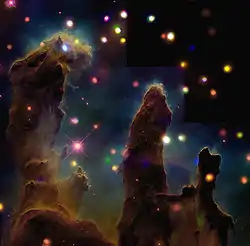Interstellar medium
In astronomy, the interstellar medium (sometimes called the ISM) is the tenuous gas and dust that fills the void between stellar systems in galaxies, that consisting mainly of huge clouds of ionized, neutral, or molecular hydrogen.[1][2] This gas and dust not distributed uniformly in interstellar space, but displays significant variations in density, temperature, and ionisation state.[2]

Eagle nebula. Pillars made of dense cold gas are visible.
Various gases exist in outer space. Most common are hydrogen and helium. Interstellar cosmic dust makes nebulae.
References
- "Definition of interstellar medium | Dictionary.com". www.dictionary.com. Retrieved 2020-10-05.
- Snell, Ronald L. (2011). Gargaud, Muriel; Amils, Ricardo; Quintanilla, José Cernicharo; Cleaves, Henderson James (Jim); Irvine, William M.; Pinti, Daniele L.; Viso, Michel (eds.). Encyclopedia of Astrobiology. Berlin, Heidelberg: Springer. pp. 837–843. doi:10.1007/978-3-642-11274-4_801. ISBN 978-3-642-11274-4.
This article is issued from Wikipedia. The text is licensed under Creative Commons - Attribution - Sharealike. Additional terms may apply for the media files.